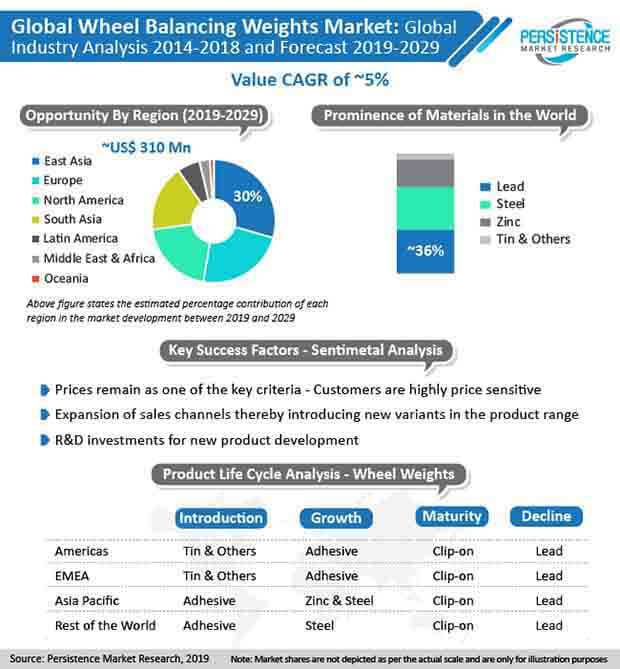Wheel Balancing Weights Market Segmented By Clip-on Weights, Adhesive Weights Product Type with Material used Lead, Zinc, Steel, Tin in Steel Wheel and Alloy Wheel Type
Industry: Automotive & Transportation
Published Date: August-2019
Format: PPT*, PDF, EXCEL
Delivery Timelines: Contact Sales
Number of Pages: 280
Report ID: PMRREP24439
The report covers a complete study of the wheel balancing weights market with an analysis of types of wheel balancing weights. The report summarizes the parent market for wheel balancing weights and markets, which are going to impact the growth of the wheel balancing weights market. It provides a brief description about how the wheel balancing weights market will perform in various regions around the world according to the previous performance and future potential in respective regions.
Balancing is an important and indispensable part of tire service. Whether during the purchase of new tires or having tires rotated, rebalancing the wheel is necessary in the vehicle. According to the market estimates, the global wheel balancing weights market is foreseen to reach ~US$ 750 Mn by the end of the forecast period, registering ~CAGR of 5%.
The main reason cited for the increase in the wheel balancing market size is the necessity of wheel balancing for comfort and control tire wear. Additionally, based on the considerations outlined in the report, zinc or lead wheel weight lost on the roadway have much higher potential impacts to the human health and the environment as compared to steel.
Therefore, the global market for wheel balancing weights for steel material appears promising with a CAGR of ~6%, mainly driven by Europe and Asia Pacific.

As per the market consensus, there are mainly two alternatives for conventional lead-based wheel balancing weights i.e. steel-based wheel weights. Steel-based wheel balancing weights are the preferred alternative by consumers due to its high density, small size, environment-friendly composition, and cost advantage.
According to PMR estimates, the global automotive aftermarket industry is anticipated to reach ~US$ 800 Bn by 2020. Nowadays, consumers are well aware of replacing the wheel components such as wheel balancing weights in well-time to maximize the life expectancy of vehicles. Thus, the rising demand for wheel balancing weights in the aftermarket is expected to create new growth opportunities for the business.
With changes in the legislation and regulations in Europe and North America, movements are being carried out by OEMs to adopt greener alternatives for wheel balancing weights. To eliminate the amount of lead-based wheel balancing weights in the vehicle, polymer-coated zinc or steel wheel balancing weights are becoming the only substitutions for wheel balancing weights.
The wheel balancing weights market is substantially impacted due to the cyclic trends in the automotive industry. Currently, India has been witnessing a slow demand for automobiles against the backdrop of inefficient fiscal and monetary policies. Subsequently, the demand for wheel balancing weights in the OEM segment is set to plunge. However, a modest future outlook is foreseen.
Consumer preferences for driving seem to shift towards passenger cars accessories, predominantly, compact and mid-size vehicles. Automotive markets in Turkey and Eastern Europe, have a combined annual sales volume of over 25 million vehicles translating a future substantial growth scenario for the wheel balancing weights market.
Moreover, among all the wheel types, alloy wheels are anticipated to experience robust growth for the adoption of wheel balancing weights. Besides, alloy wheels are used in new passenger cars to conserve the vehicle weight.
Unprecedented change in the automotive industry and its potential impact on suppliers of wheel balancing weights have been assessed. Moreover, plausible manufacturing outlook for wheel balancing weights has boosted the sentiments of manufacturers.
In terms of market structure, the wheel balancing weights market shows a perfect competitive scenario; where enormous brands are flooded in the market. More than 80% of the global wheel balancing weights market is led by top 8-10 brands/companies.
Few of the strategies adopted by wheel balancing weights market players includes a wide array of organic strategies. For instance, as a prominent OEM supplier, Plombco began the production of lead-free wheel balancing weights in 2000 and resulted in the launch of zinc-based wheel balancing weights 2003.
| Attribute | Details |
|---|---|
| By Product Type |
|
| By Material Type |
|
| By Vehicle Type |
|
| By Wheel Type |
|
| By Sales Channel |
|
| By Region |
|
To know more about delivery timeline for this report Contact Sales
